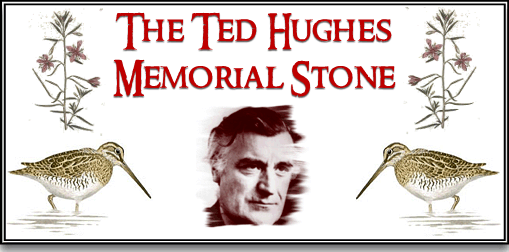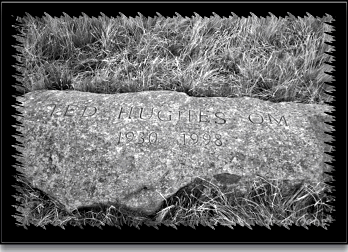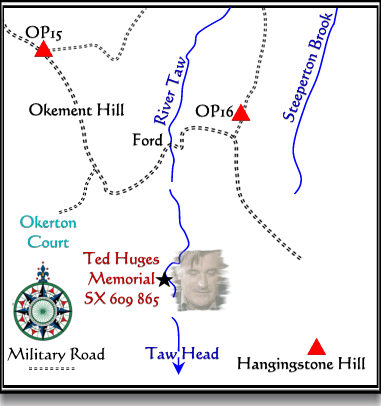
In 1961 Ted Hughes moved to the small village of North Tawton which is just outside the boundaries of the National Park. During the 1970’s he worked on his father-in-law’s farm where he recorded his experiences in a collection of poems called ‘Moortown’. He also loved to walk the moor and again the Taw and Dart rivers gave him the inspiration for another collection of poems called ‘The River’, in 1984 he became the poet laureate. Sadly in 1998 Ted Hughes died of cancer and was cremated on the 3rd of November. In accordance to his wishes and will his ashes were scattered at a private ceremony near to Taw Head. He had also expressed a wish that a simple granite stone be engraved with his name and sited near the rising of the Taw, Dart, East Okement and Teign rivers and the task was given to his friend Ian Cook.
It is current Duchy policy to deter the erection of any memorial on Dartmoor and despite having the Prince of Wales’ sanction it was not until the November of 2001 that the memorial was flown by helicopter to its specified location. In order for this to take place permission had to be obtained from English Nature and the Dartmoor National Park Authority who took advice from their ecology and archaeology experts.

The Ted Hughes Memorial Stone
The memorial’s exact location was kept a close secret for several suggested reasons. It was thought that if the whereabouts of the memorial was known it could possibly became a ‘shrine’ for his many fans and admirers which would be contradictory to his ‘private nature’. Another theory was that in light of the suicide of his former wife, Sylvia Plath, there was a very real danger that the memorial would be vandalised by sympathetic feminists. There was also some talk of the military objecting to the memorial because Ted Hughes was a vocal conservational campaigner against the use of Dartmoor for military training. The actual granite for the memorial is thought to have come from an area just east of Beardown Woods.
As with many things on Dartmoor it is only time before an sharp eyed walker comes across a ‘new’ feature and this memorial was no exception. In the summer of 2003 the location of the stone was widely reported in the national press and it did not take long for the grid co-ordinates to become local knowledge. There was a mixed local reaction to the memorial with comments ranging from, “I‘m disappointed that this memorial was permitted. There are any number of other Devonians who are equally deserving,” to “Ted Hughes was inspired by the nature surrounding him. he had great ideas and many great feelings as he wrote his work. “

SNIPE
You are soaked with the cold rain –
Like a pelt in tanning liquor.
The moor’s swollen waterbelly
Swags and quivers, ready to burst at a step.
Suddenly
Some scrap of dried fabric rips
Itself up
From the marsh-quake, scattering. A soft
Explosion of twilight
In the eyes, with spinning fragment
Somewhere. Nearly lost, wing flash
Stab-trying escape routes, wincing
From each, ducking under
And flinging up over –
Bowed head, jockey shoulders
Climbing headlong
As if hurled downwards –

A mote in the watery eye of the moor –
Hits cloud and
Skis down the far rain wall
Slashes a wet rent
in the rain-duck
Twisting out sideways –
rushes his alarm
Back to the ice age.
The downpour helmet
Tightens on your skull, riddling the pools,
Washing the standing stones and fallen shales
With empty nightfall.
Ted Hughes – The Snipe 1981.
For anybody who has trudged laboriously through the sodden tussocks on a wet day this poem will strike a chord of recognition. The rain is pelting down at an angle of 22.5° you are hunched up, head bent in your raincoat and the drips rhythmically cascading off your forehead. Usually you are deep in melancholy thought when all of a sudden a hidden form explodes out from under your foot with a loud, indignant ‘skeep’. Your heart jumps and when you look up you see a flash of dark brown and white frantically zig-zagging low over the moor – “Jack Snipe.”
 Legendary Dartmoor The many aspects past and present of Dartmoor
Legendary Dartmoor The many aspects past and present of Dartmoor

Is it true the granite came from near East Beardown woods? And who carved Ted’s name on the stone?
Yes did he live at Meluishes, where my Tavener grandparents formerly lived?
Would like to know what has happened to this and Barton House near the mill run by my grandfather.
Thanks C.Ross